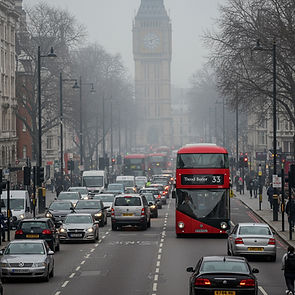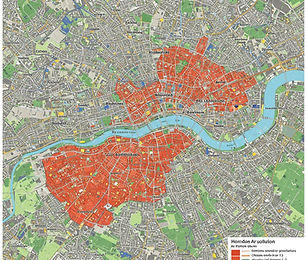Air Quality in London: A Guide forTraveler (2025)
The Guide on Air Pollution for travelers to London
Air Pollution in London: Facts Summary
-
Air pollution in London is a significant issue, particularly with high levels of nitrogen dioxide (NO2) and particulate matter (PM2.5).
-
The primary causes are vehicle emissions, especially diesel cars, and wood-burning stoves.
-
High-risk areas for pollution are typically major roads and congested zones like the city center.
-
Prevention is key: use the extensive public transport network, walk in parks, and monitor air quality apps.
-
Travelers with respiratory conditions, the elderly, and children are most vulnerable to the effects of poor air quality.

Air Quality in London: Essential FAQ
1. Is London's air quality dangerous for all travelers?
While London's air pollution can affect anyone, those with pre-existing respiratory or heart conditions, the elderly, and children are the most vulnerable. Even healthy adults may experience minor symptoms like a cough or eye irritation during periods of high pollution.
2. How does London's air quality compare to other major European cities?
London's air quality has improved in recent years but still presents challenges. It's often comparable to other major cities, with pollution from traffic being the main issue. The city's extensive public transport system and green spaces offer a good way to mitigate exposure.
3. Are there any apps that provide real-time air quality data for London?
Yes. Several popular apps and websites provide real-time air quality data and forecasts for London, including the official London Air Quality Network and private apps like IQAir and Plume Labs.
4. Is it safe to exercise outdoors in London?
It is generally safe, but you should check the air quality forecast for the day. It's best to exercise in one of London's royal parks or early in the morning when pollution levels are typically lower. Avoid strenuous activity along busy, congested streets.
5. Does air pollution in London cause long-term health effects for a short-term visitor?
For most healthy individuals, a short visit (a few days to weeks) is unlikely to cause long-term health problems. However, taking precautions to minimize exposure is always recommended to avoid immediate discomfort and support your overall well-being.
6. What is the Ultra Low Emission Zone (ULEZ)?
The ULEZ is a designated area in London where vehicles that don't meet strict emissions standards must pay a daily charge. This initiative has been successful in reducing vehicle pollution, especially in the city center.
7. Will wearing a mask make me stand out as a tourist?
No. Following the pandemic, wearing masks has become much more common. Many locals wear them during high-pollution periods, especially when using public transport or walking along busy streets.
8. How do I get medical help if I have a severe reaction to the air pollution?
For severe respiratory symptoms, you should seek immediate medical attention at a local hospital or clinic. Your hotel staff or a local guide can assist you in finding the nearest medical facility.
What Every Visitor should to Know to Breathe Easy in London
London, one of the world's most vibrant and historical capitals, attracts millions of visitors each year. From the iconic landmarks of Westminster to the cultural buzz of the East End, the city offers an endless array of experiences. However, like any major global city, London faces challenges with air quality. Understanding the air you breathe is essential for a safe and comfortable trip, especially for those with health sensitivities.

1. The State of Air in the British Capital
London's air quality has seen significant improvements in recent years due to initiatives like the Ultra Low Emission Zone (ULEZ), but pollutants remain a concern. The main pollutants are nitrogen dioxide (NO2) from vehicle exhaust and particulate matter (PM2.5), a mix of tiny solid and liquid particles from various sources, including traffic, industrial activity, and even domestic heating.
According to a report from Imperial College London, despite reductions, the city's air quality still falls below World Health Organization (WHO) guidelines. For instance, in 2024, some areas of central London continued to exceed the legal annual average for NO2.
Several factors contribute to London's air quality issues:
-
Traffic Volume: Despite ULEZ, a high volume of vehicles on the roads, particularly in central areas, remains a major source of emissions.
-
Seasonal Factors: Weather plays a significant role. During winter, still air and cold temperatures can trap pollution close to the ground.
-
Domestic Heating: In colder months, the use of wood-burning stoves and other heating methods can contribute to particulate matter pollution in residential areas.
2. Seasonal Variations and the Best Time to Visit
Air quality in London varies throughout the year. Knowing the seasonal patterns can help you plan your trip for a more comfortable experience.
-
Winter (November-February): This is generally the worst time for air quality. Cold, still weather can lead to temperature inversions, which trap pollutants near the ground.
-
Summer (June-August): While the risk of NO2 pollution from traffic is still present, better air circulation can help disperse pollutants. However, hot, sunny days can lead to elevated levels of ground-level ozone (O3), a key component of smog.
-
Spring & Fall (March-May & September-October): These are often the best seasons for air quality. Milder weather, a mix of rain and sunshine, and lower heating usage generally result in cleaner air.
The best time to visit London for optimal air quality is during the spring and fall shoulder seasons, specifically April-May or September-October. This period offers a perfect balance of pleasant weather and cleaner air, making it ideal for sightseeing.
3. Where to Find the Best and Worst Air Quality in London
Air quality varies dramatically across London's boroughs. Knowing where to go and where to avoid can significantly reduce your exposure to pollutants.
-
Worst Air Quality (High Pollution Hotspots):
-
Major Roads: Streets like Oxford Street, Marylebone Road, and the areas surrounding major motorways like the M25 and M4 are consistently among the most polluted.
-
Congestion Zones: The Central London Congestion Charge zone and other areas with heavy traffic, such as around tourist attractions, often have higher levels of pollution.
-
Transport Hubs: Areas near major train stations like Victoria, London Bridge, and Waterloo can be pollution hotspots due to high volumes of bus and taxi traffic.
-
-
Best Air Quality (Clean Air Zones):
-
Parks and Green Spaces: London has a wealth of green spaces that act as the city's lungs. Spending time in Hyde Park, Regent's Park, Kew Gardens, or Richmond Park can provide a welcome respite from urban pollution.
-
Riverside Walks: Walking along the Thames Path, away from busy bridges and roads, can offer a cleaner-air experience.
-
Suburban Areas: Residential neighborhoods away from major transport links generally have much cleaner air.
-
4. Essential Strategies for Breathing Easy in London
Don't let concerns about air quality deter you from experiencing the magic of London. With these practical tips, you can minimize the impact of pollution and focus on your trip.
-
Time Your Itinerary Wisely: Plan to visit outdoor attractions in the morning or on days with a good air quality forecast. Use apps to check pollution levels before you leave your hotel.
-
Use Public Transportation: London's Tube and overground train network is extensive and offers a fantastic way to travel without contributing to or being exposed to street-level pollution.
-
Stay Informed: Use real-time air quality apps and websites to check the pollution levels in different parts of the city. This knowledge is your best tool for making informed decisions on the go.
-
Protect Yourself: On high-pollution days, consider wearing a high-quality face mask (FFP2). A scarf or buff can also offer a basic level of protection from particulate matter.
Key Sources of Information:
-
London Air Quality Network: An official source for real-time air quality data across London.
-
Imperial College London: Provides expert analysis and reports on London's air pollution trends and health impacts.
-
UK Department for Environment, Food & Rural Affairs (DEFRA): Offers national air pollution statistics and forecasts.
-
World Health Organization (WHO): Publishes air quality guidelines that cities are measured against.

